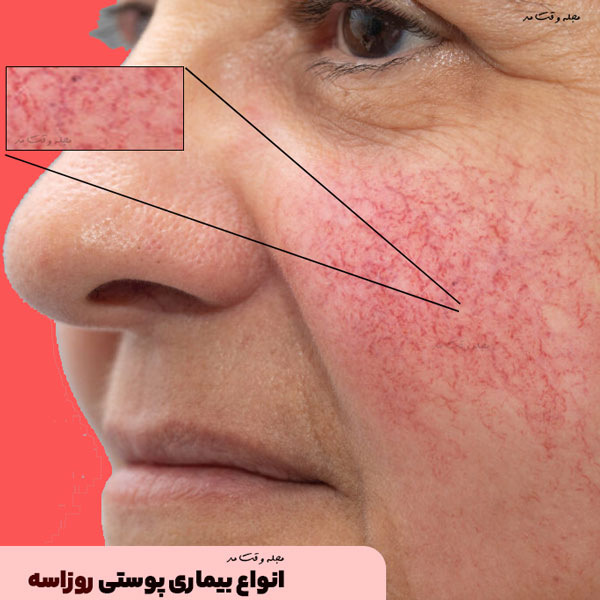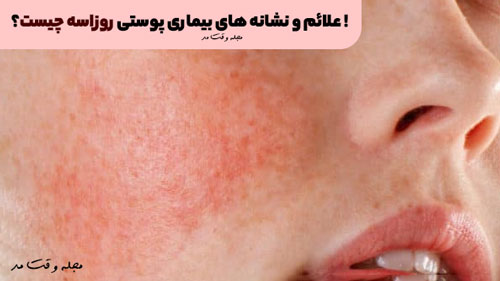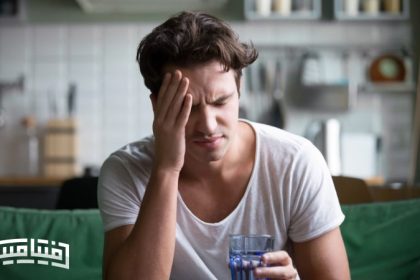Rosacea (rosacea), is a skin disease that causes redness of the skin. Most of the nose, cheek and forehead are the symptoms of rosacea. This disease generally starts after the age of 30. Medications, creams, and lotions help reduce the symptoms of rosacea.
In this section of health magazine Vaghtemod.ir (vaghtemod.ir) facts Rosacea skin disease, its symptoms and treatment methods We have explained and described the amazing features and symptoms of rosacea.
What is rosacea?
According to webmd, rosacea (rosacea) is a skin disease, which causes redness and inflammation of the skin. There may be bumps and pus in the inner part of this skin redness and it looks like acne. The symptoms of this disease are different based on skin color.
Redness and inflammation are generally more obvious on white and fair skin, but on brown or dark skin, the spots of rosacea can hardly be seen.
If you have symptoms like; Red and small bumps, bumps containing pus, burning and sensitivity, you may have rosacea skin disease. The specialist doctor suggests medicine and other treatments based on the type of rosacea described below to manage this disease.
Learn more: Know the types of acne on the face and body, its cause, diagnosis and treatment!
Types of rosacea
There are 4 types of rosacea, but you can have symptoms of more than one type of this skin disease at the same time. Rosacea disease depends a lot on skin color and type. In the continuation of the series of skin health educational materials from the fashion magazine, you will get to know the types of this disease.

rosacea erythema totelangiectatic (Erythematotelangiectatic rosacea)
This type of rosacea is stable and can be seen with redness of the skin along with small blood vessels under the skin.. The symptoms of rosacea erythema totelangiectatic appear unexpectedly and disappear, but without follow-up and treatment, the redness and inflammation of the skin will worsen day by day.
Learn more: types of skin wrinkles, causes and treatment.
papulopustular rosacea (Papulopustular rosacea)
This type of skin disease causes whiteheads with pus and red and swollen bumps that are very similar to acne. Papulopustular rosacea can appear on the forehead, cheek, chin, and even on the scalp, chest, and neck. If the symptoms are severe, the duration of treatment will be longer.
Learn more about skin beauty: the best ways to tighten the skin! The latest method to tighten sagging skin.
phymatous rosacea (Phymatous rosacea)
In this type of disease, the skin becomes thick and red and often affects the nose and causes swelling, swelling and redness on the nose. Symptoms of phymatous rosacea make the nose look bulbous.
Learn more: What is skin eczema? Types of eczema, symptoms, causes, prevention and treatment of skin eczema.
ocular rosacea (Ocular rosacea)
This type of rosacea affects the eyes and causes the eyes to look bloodshot and watery. In ocular rosacea, the eyes become dry, sensitive to light, and cause cysts to form on the eyelids.
Learn more: Why does blackness under the eyes occur!? 12 ways to treat dark circles under the eyes.
What are the symptoms of rosacea?
According to nhs, for people with light skin, the first visible redness of the skin is on the nose, cheeks, chin and forehead. After some time, small blood vessels appear from under the skin and become swollen and thick.


Half of people with rosacea have eye problems such as pain, swelling, and redness. Other symptoms of rosacea include:
- Burning skin is one of the symptoms of rosacea.
- Red pimple-like bumps that may contain pus.
- Facial skin spots are another symptom of rosacea.
- swollen nose
- Large pores on the skin are signs of rosacea.
- Bump on the eyelid
- Vision problems are one of the symptoms of rosacea.
- Identification of blood vessels above the eyelids and face
Symptoms of rosacea come and go unexpectedly and reappear after a few weeks. The treatment of this type of skin disease is necessary, if the treatment is not followed, the symptoms get worse day by day.
Learn more: facial filler! The enemy of your health or your beauty companion! Complications, benefits of filler, gel or face filler.
What factors cause rosacea?
Doctors do not know exactly what causes rosacea, but a few factors that may play a role include:
- Genetics is one of the most important factors in the occurrence of rosacea.
- Blood vascular problems make the veins under the skin visible.
- A bacterium called Helicobacter pylori normally lives in the intestine. This microbe can increase the amount of digestive hormone gastrin and cause redness of the skin.
- Intense and heavy sports
- Alcohol consumption is one of the causes of rosacea.
- Being in the sun for a long time
- Another cause of rosacea disease is unbalanced air. (very cold or very hot weather)
- pressure sickness
- Menopause
People who have fair skin and eye color and blond hair, have severe acne, are women, and are between 30 and 50 years old are more likely to suffer from rosacea.
Learn more: What is a skin facial? With types of application, side effects, benefits, facial and skin facial procedures, aftercare.
How is rosacea diagnosed?
To diagnose rosacea, the doctor does a general examination of the patient and obtains the patient’s medical records. During the examination, you should discuss with your doctor all your skin problems, including swelling, burning, and rashes. There is no specific test to diagnose rosacea, however To treat this skin disease, it is better to see a dermatologist.
Learn more: What is primer and what is its use? Know the benefits, disadvantages and how to use primer!
Treatment of rosacea
There is no definitive treatment for rosacea; But some drugs and methods help to manage and control this disease.
The doctor may suggest the following drugs to treat rosacea (do not take any of these drugs without a doctor’s prescription):
- Azelaic acidIt is a gel or foam that reduces or eliminates swelling, swelling and redness of the skin.
- BrimonidineIt is a gel that tightens the red veins under the skin and reduces swelling.
- Clindamycin (Cleocin, Clindagel, ClindaMax)It is an antibiotic that kills bacteria on the skin.
- Erythromycin (Erythromycin), Another antibiotic prescribed by the doctor for the treatment of rosacea can be.
- Isotretinoin (Isotretinoin), It is a medicine to treat acne. Do not use this medicine if you are pregnant.
- Ivermectin (Ivermectin), It is a topical medicine that is used on the skin and is used to reduce the symptoms of rosacea.
After a few weeks or months of taking these drugs, you can see signs of improvement. In addition to prescribing medication, your doctor may use a laser to heal large and small blood vessels.
dermabrasion or sabi skin; Another treatment method is rosacea. Also, electrocautery, which destroys damaged blood vessels, is another best way to heal rosacea.
Learn more: the best and fastest way to treat subcutaneous acne! All important facts about cystic acne treatment.
How to prevent rosacea skin disease?
Since the cause of rosacea is unknown, this disease cannot be prevented. You can reduce your risk of developing rosacea by identifying and avoiding things that trigger your symptoms.
Always be careful when going out in the sun and use the right sunscreen. Eat a healthy diet and avoid spicy food.
Read more: Sunscreen spray! Complications, benefits, introduction of very important things in this regard.
RCO NEWS
RCO















